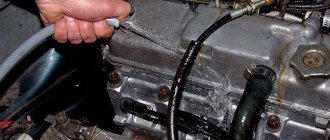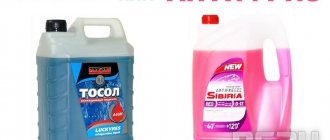Dirt affects your car's paintwork in much the same way as sand or bird feces. If a dirty car is covered with ice, then the frost, together with the reagents that get on the body along with the dirt, will quickly cause corrosion, and after a couple of seasons the body will not only lose its attractive appearance, but will also acquire a serious layer of rust. Industrial salt is considered the most harmful reagent for car coating: it is most often used to melt snow on roads. Salt corrodes the varnish, destroys the paint and allows moisture to reach the car body. This reagent is not harmful to rubber, so it is important to wash off dirt, snow and salt from the body in a timely manner.
Sometimes washing your car in winter is simply necessary. How best to do this - read on
How to wash your car in winter to avoid problems
If you know when the frost will hit, it is better to wash your car before it arrives. If it’s zero outside, then there’s dirt everywhere, and there’s no point in washing the car. There is much less dirt in cold weather, but is it worth washing a car at sub-zero temperatures? This can be done, but after the car is washed, it is necessary to open the doors and dry them, otherwise the doors will freeze and stop opening.
Need to quickly defrost your car locks? Find out the most effective way to do this.
If you need to warm up the entire car, watch how it's done.
In places where water or debris may accumulate, it needs to be wiped off; A sponge or rag is suitable for this. It is important that no water remains in such a place. Rubber seals are treated with silicone grease - this substance displaces water and prevents the material from expanding and deteriorating. After such treatment, rubber products will not freeze to other elements of the car. The same lubricant can be used to treat door locks and door hinges.
Wash the car yourself
First of all, you need to know that if the thermometer shows below -15 degrees, then it’s better to forget about washing that day. The fact is that in the cold, the remaining water will freeze quite quickly and can cause harm to those parts of the car in which it remains. In other words, the ice that forms can damage the glass of headlights, windows, and even rupture the radiator.
Before washing your car in winter, remove all floor mats from the interior. It seems like a small thing, but in fact it is very important. The fact is that in winter snow gets under the rugs. It can accumulate there in large quantities, and if the mats with snow are not removed, the snow will melt during washing. As a result, at a minimum, an unpleasant odor may appear in the cabin. In a worst-case scenario, the area may rust, leaving an unwanted hole in the body.
If you do not have a special high-pressure pump, then you will have to buy several special sponges. Before washing, first warm up the car, and then pour three buckets of warm water over it - the dirt needs to be soaked. The water should be warm enough so that during the entire procedure it has time to remove dirt without freezing.
We are talking specifically about warm water, but in no case about boiling water. You cannot use too hot water in winter, otherwise you may damage the paintwork. For example, if it is minus 10 outside, then the water temperature should not be higher than plus 40 degrees.
It is advisable to wash the body as a whole at once - no need to do it in parts. Wash the top first, because it gets dirty the least, which means that the water and sponges will also get slightly dirty. In addition, the solution flowing from the top of the body will additionally wash away the lower contaminants.
What detergents to use
Under no circumstances use synthetic compounds that are used in washing machines to wash your car. These solutions are filled with alkali, which will certainly cause oxidation of the metal upon contact with it.
If you were unable to purchase a special car shampoo, you can use dishwashing detergent. These reagents are relatively neutral and are not capable of causing significant harm to paintwork.
Cleaning the interior
The car, of course, must be clean not only outside, but also inside. We wash the floor mats thoroughly, and don’t forget about the trunk, as well as the engine compartment. It is especially important to remove dirt from the wiring, otherwise the battery will discharge faster and the engine will start intermittently. Before washing the interior, protect the locks and door hinges with a special compound that does not allow moisture to pass through. For example, you can use WD-40. On some VAZ models, the lock may still freeze. You can warm it up with a cigarette lighter by pressing it against the keyhole.
Wash wheels, license plates and bumpers
Now let's say a few words about how to wash the dirtiest parts of the car - both bumpers, wheel rims and license plates. There is no need to think too much here. Just know that these parts need to be washed with separate water from a separate container. And you also need to use a separate sponge. By the way, all optics should also be washed separately.
Seal care
Rubber seals also need maintenance. After you have finished washing the car, wipe all seals dry and then coat them with glycerin. As a result, they will not freeze and tear when opening the doors. In addition, glycerin maintains the elasticity of rubber products.
After washing the car, it is recommended to keep the doors open for two to three minutes. This will allow excess moisture to evaporate.
How to wash a car outside in winter?
If you need to wash a car parked on the street yourself, you can do this by following these rules:
- Do not pour too hot water on the body, as a sudden temperature change will cause damage to the paint layer.
- After washing, you need to thoroughly dry the car and wipe off any remaining liquid. It is dangerous to leave moisture on the wings and any other parts of the body, since the water may contain residues of technical salt. Having clogged up in the microcracks of the varnish, it will freeze and expand, thus destroying the coating and allowing the salt to reach the paint.
- To prevent the car from freezing after washing, it is dried using compressed air or a hair dryer.
- If the car is left outside after washing, you need to start the engine and turn on the heater in the cabin, while opening the doors. Don’t be afraid to heat the street in this way, as this procedure evaporates excess moisture from the interior and dries it with air. Ten minutes of this procedure will be enough.
- The wipers need to be raised until the body is dry, otherwise they will stick.
Watch a video about how professionals advise washing your car in the cold season
Do you need to wash your car in winter?
Maybe somehow it will work itself out? Let’s say right away – it won’t work, and the car needs to be washed regularly throughout the year.
You need to know that dirt has no less detrimental effect on a car’s paintwork than, say, bird droppings or sand. And if the dirty car is also covered with ice, then it will be a truly hellish mixture for the paintwork. The beginning of body corrosion will be ensured, and after two or three seasons the layer of rust will be very noticeable, which will significantly spoil the appearance of the car and create a real threat to the integrity of the body.
The most destructive reagent is industrial salt, which is used to cover roads to melt snow. Salt destroys the paintwork, making the body vulnerable to moisture. It must be said that rubber is not afraid of salt at all, so it is extremely important to regularly wash off salt dirt from the body.
How often should you wash your car?
The frequency of winter car washing largely depends on the nature of the car’s operation, as well as on the quality of the roads. If you use your car every day, you should wash it at least twice a week. And if you go out quite rarely, and the car spends most of its time in the garage, then in this case it is enough to wash the car twice a month. And, of course, it is necessary to take into account the nature of the pollution and its quantity.
Should you wash your car yourself in winter?
Professionals do not recommend that car enthusiasts wash their cars with their own hands during the cold season. No matter how hard you try, you will never “outdo” automatic washing, which is carried out in a special box using all the necessary technologies. Therefore, it is better to wash your car in a specialized car wash in winter.
But if this is not possible, then, willy-nilly, you will have to wash the car yourself. We will definitely talk about how to do this, but for now we will give some recommendations regarding professional car washes that you can contact in the winter.
Where to wash your car in winter
Washing a car outside on your own in winter is not a pleasant task, so if you don’t want to do this, you can go to a car wash.
You need to be more careful when choosing a car wash in winter. Please pay attention to the following points:
- The sink should have a warm, lockable box, and the temperature of the supplied water should vary between 20-30 degrees.
- If the car is snowy, then before washing it, it needs to warm up for about 15 minutes and the snow or ice on the body will melt, otherwise a strong temperature change can destroy the varnish on the car.
- Keep track of what kind of foam is used, since for the winter period they use a special substance that can combat reagents. This foam also has additives that prevent it from freezing.
- Pumps for washing cars should produce greater pressure, so that no traces of dirt and salt remain on the body.
- At high-quality car washes, before work, employees treat the rubber elements of the car, locks and door hinges with water-repellent silicone lubricant, otherwise the locks will stop opening and the rubber bands will crack. For safety reasons, it is recommended to do this yourself.
- There is no need to wash the engine, chassis of the car and the inside of the wheels in winter.
- At the car wash, you must thoroughly dry the body and interior of the car and only then roll the car out onto the street. The cracks need to be treated with heated compressed air.
Make sure there is no water left anywhere. It can accumulate on fenders, sills, doorways, and headlight cracks. Any parts can crack if water gets into them and further freezes.
Need for washing
Many car owners ask whether to wash their car in winter, and at what frost it can be done so as not to cause harm. Some drivers drive dirty “iron horses” all winter, others wash them with their own hands from a bucket. Still others turn to car washes. When we wash our car in winter, we are afraid that moisture will not get into problem areas.
Roads in cities are often sprinkled with salt in winter to prevent ice. It is an aggressive substance that corrodes paintwork and metal. Your car may lose its beauty, and the body will begin to rust.
If you remember your chemistry lessons, they say that temperature affects chemical reactions. If there is severe frost in winter, the body will not rust, even if covered with road salt. Corrosion will begin to do its work only during thaws. In warm regions, the roads are always muddy in winter, so you need to wash your car more often in winter.
Possible problems
- If you do not follow the rules for washing your car in the winter, you may encounter the following troubles:
- The rubber parts of the machine are cracking.
- Water that suddenly freezes on the glass will cause a crack. The same goes for mirrors and headlights.
- Sudden changes in temperature can lead to cracks in the body or glass.
- Do not put the car on the handbrake, as in cold weather this may cause the pads to freeze to the brake discs. In this case, the car will not move until the pads thaw.
- The wipers stick to the wet glass.
- Rubber bands that are not lubricated with water-repellent grease crack, and locks do not open or close.
- If water gets into cracks in the paintwork and then turns to ice, it will cause damage to the paintwork that will lead to rust in the future.
Winter wash
With the development of scientific progress, cars have ceased to be a luxury item, but have become an everyday thing that is in many people's garages.
Using transport significantly saves time and resources. The time and physical effort that a person spends on the road are noticeably reduced. However, we should not forget that equipment requires constant care, and a car is no exception. For many people, a car is not a means of transportation, but a real family member. Therefore, it is necessary to care for equipment with the utmost care and attention. In the summer, caring for a vehicle is not something difficult, but everything changes with the onset of cold weather. At subzero temperatures, a car consumes significantly more internal resources, and caring for it becomes more difficult.
How to clean grease from a kitchen hood. Read how to remove brilliant green from skin here.
For information on how to remove excess fluid from the body, read the article:
As you know, in the modern world, a car is the second face of a person. If it is clean and well-groomed, then so is its owner. If it is constantly dirty, then this indicates that its owner is a careless and sloppy person. A lot depends on cleanliness, including the performance characteristics of the vehicle.
Many people wonder how to properly wash vehicles in winter and how often this should be done. There is no clear answer to this question. Everyone must decide for themselves how and when to do this. It is clear that car washing should be carried out with an eye on current weather conditions. If there is snow or slush outside, then there is no point in washing the car, since immediately after leaving it it will become dirty again. In addition, experts categorically do not recommend washing your car if the outside temperature drops below -10 C.
Important! Winter car washing is an important process. Roads are sprinkled with a variety of reagents that can adversely affect the car. Therefore, it is necessary to wash the car, otherwise its technical and operational characteristics may deteriorate.
Currently, during the winter, you can wash your car in two ways: yourself and at a specialized car wash. The easiest way is to take your car to a wash. Specialists will be able to rid your vehicle of contaminants and cover the car with a protective layer that will resist the action of chemicals. In addition, there are services where the process takes place with the active participation of the car owner. These are so-called self-service car washes.
If you intend to wash the car yourself in your yard, then things are much more complicated. For this process you will need a significant amount of heated water (experts recommend washing your car in winter with water whose temperature is not lower than 35-40 C). In addition, you need to stock up on other tools. In particular, we are talking about a variety of brushes and rags, and special water-repellent and antifreeze agents. You can purchase all this in the nearest stores that sell products for car care.
Bottom line
You can avoid these difficulties if you follow simple rules for washing your car during the cold season. Do not forget that in this case it is important not to harm the car.
Dear readers! We constantly write relevant and interesting materials for our online magazine ProCrossover, subscribe to our channel in Yandex-Zen!
Dear readers! We constantly write relevant and interesting materials for our online magazine ProCrossover, subscribe to our channel in Yandex-Zen!











